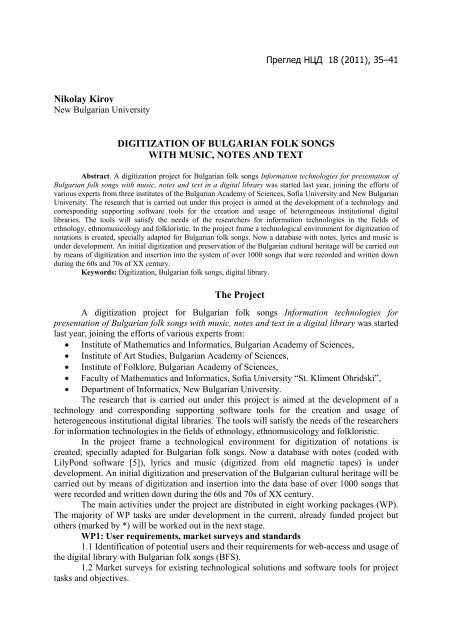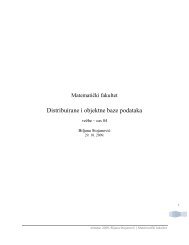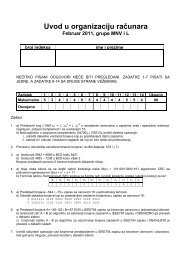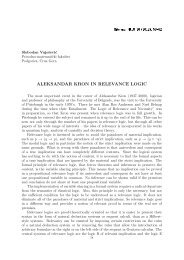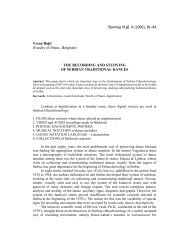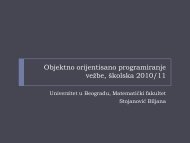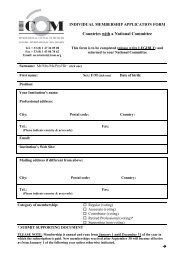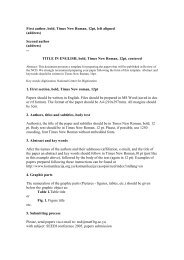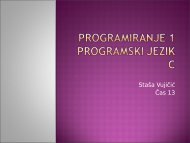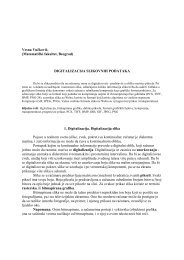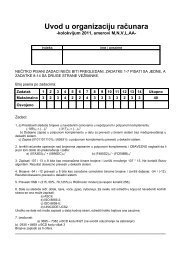Digitization of Bulgarian Folk Songs with Music, Notes and Text
Digitization of Bulgarian Folk Songs with Music, Notes and Text
Digitization of Bulgarian Folk Songs with Music, Notes and Text
You also want an ePaper? Increase the reach of your titles
YUMPU automatically turns print PDFs into web optimized ePapers that Google loves.
Преглед НЦД 18 (2011), 35–41Nikolay KirovNew <strong>Bulgarian</strong> UniversityDIGITIZATION OF BULGARIAN FOLK SONGSWITH MUSIC, NOTES AND TEXTAbstract. A digitization project for <strong>Bulgarian</strong> folk songs Information technologies for presentation <strong>of</strong><strong>Bulgarian</strong> folk songs <strong>with</strong> music, notes <strong>and</strong> text in a digital library was started last year, joining the efforts <strong>of</strong>various experts from three institutes <strong>of</strong> the <strong>Bulgarian</strong> Academy <strong>of</strong> Sciences, S<strong>of</strong>ia University <strong>and</strong> New <strong>Bulgarian</strong>University. The research that is carried out under this project is aimed at the development <strong>of</strong> a technology <strong>and</strong>corresponding supporting s<strong>of</strong>tware tools for the creation <strong>and</strong> usage <strong>of</strong> heterogeneous institutional digitallibraries. The tools will satisfy the needs <strong>of</strong> the researchers for information technologies in the fields <strong>of</strong>ethnology, ethnomusicology <strong>and</strong> folkloristic. In the project frame a technological environment for digitization <strong>of</strong>notations is created, specially adapted for <strong>Bulgarian</strong> folk songs. Now a database <strong>with</strong> notes, lyrics <strong>and</strong> music isunder development. An initial digitization <strong>and</strong> preservation <strong>of</strong> the <strong>Bulgarian</strong> cultural heritage will be carried outby means <strong>of</strong> digitization <strong>and</strong> insertion into the system <strong>of</strong> over 1000 songs that were recorded <strong>and</strong> written downduring the 60s <strong>and</strong> 70s <strong>of</strong> XX century.Keywords: <strong>Digitization</strong>, <strong>Bulgarian</strong> folk songs, digital library.The ProjectA digitization project for <strong>Bulgarian</strong> folk songs Information technologies forpresentation <strong>of</strong> <strong>Bulgarian</strong> folk songs <strong>with</strong> music, notes <strong>and</strong> text in a digital library was startedlast year, joining the efforts <strong>of</strong> various experts from:• Institute <strong>of</strong> Mathematics <strong>and</strong> Informatics, <strong>Bulgarian</strong> Academy <strong>of</strong> Sciences,• Institute <strong>of</strong> Art Studies, <strong>Bulgarian</strong> Academy <strong>of</strong> Sciences,• Institute <strong>of</strong> <strong>Folk</strong>lore, <strong>Bulgarian</strong> Academy <strong>of</strong> Sciences,• Faculty <strong>of</strong> Mathematics <strong>and</strong> Informatics, S<strong>of</strong>ia University “St. Kliment Ohridski”,• Department <strong>of</strong> Informatics, New <strong>Bulgarian</strong> University.The research that is carried out under this project is aimed at the development <strong>of</strong> atechnology <strong>and</strong> corresponding supporting s<strong>of</strong>tware tools for the creation <strong>and</strong> usage <strong>of</strong>heterogeneous institutional digital libraries. The tools will satisfy the needs <strong>of</strong> the researchersfor information technologies in the fields <strong>of</strong> ethnology, ethnomusicology <strong>and</strong> folkloristic.In the project frame a technological environment for digitization <strong>of</strong> notations iscreated, specially adapted for <strong>Bulgarian</strong> folk songs. Now a database <strong>with</strong> notes (coded <strong>with</strong>LilyPond s<strong>of</strong>tware [5]), lyrics <strong>and</strong> music (digitized from old magnetic tapes) is underdevelopment. An initial digitization <strong>and</strong> preservation <strong>of</strong> the <strong>Bulgarian</strong> cultural heritage will becarried out by means <strong>of</strong> digitization <strong>and</strong> insertion into the data base <strong>of</strong> over 1000 songs thatwere recorded <strong>and</strong> written down during the 60s <strong>and</strong> 70s <strong>of</strong> XX century.The main activities under the project are distributed in eight working packages (WP).The majority <strong>of</strong> WP tasks are under development in the current, already funded project butothers (marked by *) will be worked out in the next stage.WP1: User requirements, market surveys <strong>and</strong> st<strong>and</strong>ards1.1 Identification <strong>of</strong> potential users <strong>and</strong> their requirements for web-access <strong>and</strong> usage <strong>of</strong>the digital library <strong>with</strong> <strong>Bulgarian</strong> folk songs (BFS).1.2 Market surveys for existing technological solutions <strong>and</strong> s<strong>of</strong>tware tools for projecttasks <strong>and</strong> objectives.
36Nikolay Kirov1.3 Metadata for folk songs.A suitable multitude <strong>of</strong> metadata for the components <strong>of</strong> the folk songs (lyrics, noterecords, musical recordings) will be determined taking into account the internationallyrecognized classification schemes <strong>and</strong> the national traditions.1.4 Integration <strong>and</strong> adaptation <strong>of</strong> existing st<strong>and</strong>ards.<strong>Digitization</strong> <strong>of</strong> the data model will be performed, based on the integration <strong>and</strong> possibleadaptation <strong>of</strong> the existing European <strong>and</strong> world st<strong>and</strong>ards (see [7]).WP2: <strong>Digitization</strong> <strong>of</strong> manuscripts <strong>and</strong> books <strong>and</strong> creation <strong>of</strong> a database <strong>with</strong> BFS(see [4] for details).2.1 Technology for coding <strong>of</strong> note records from original manuscripts <strong>with</strong> fieldrecordings.2.2* Technology for scanning <strong>of</strong> printed books <strong>with</strong> BFS <strong>and</strong> OCR <strong>of</strong> the notation inthem.2.3 Creation, support <strong>and</strong> completion <strong>of</strong> database for preservation <strong>of</strong> notes, lyrics <strong>and</strong>music recordings (see Mutopia Project [8]).WP3: Project website <strong>and</strong> Internet access to the database3.1 Project site <strong>with</strong> the description <strong>of</strong> database, technologies for database completion<strong>and</strong> tools for searching <strong>and</strong> knowledge extraction.The website will be provided <strong>with</strong> a description <strong>of</strong> the project, public documents on itsimplementation, description <strong>of</strong> the database <strong>of</strong> BFS, description <strong>of</strong> the developedtechnological environment for the introduction <strong>of</strong> musical notes <strong>with</strong> the specialized for BFStools. Instruments (tools) for working <strong>with</strong> the database will be described.3.2 Web-based access <strong>and</strong> visualization <strong>of</strong> the note records <strong>and</strong> the song lyrics (see[8]).3.3 Web-based access to metadata <strong>and</strong> musical objects <strong>of</strong> the database.The metadata in the database will be provided <strong>with</strong> public access via Internet. Everyuser will be able to get (according to the international st<strong>and</strong>ards) XML files <strong>with</strong> metadata.3.4* Visualization <strong>of</strong> geographic objects connected to geographic elements in thedatabase.The database consists <strong>of</strong> names <strong>of</strong> settlements (mainly villages) in Bulgaria, where thesongs have been recorded. These geographical data will be presented on the map <strong>of</strong> thecountry. On this map parts <strong>of</strong> the database that will come as a result <strong>of</strong> a search <strong>with</strong> setcriteria, will be presented.WP4: Research in the field <strong>of</strong> information technologies for building <strong>and</strong> using <strong>of</strong>digital libraries <strong>with</strong> BFS (see [4])4.1 Methods <strong>and</strong> tools for building heterogeneous digital libraries.4.2 Semantics oriented search in digital libraries.4.3 Knowledge extraction from databases.4.4* S<strong>of</strong>tware tools for special purpose (in particular, semantics oriented) search <strong>and</strong>knowledge extraction from a database.WP5: Scientific research in ethnomusicology (see [3] for details)5.1* Completion <strong>and</strong> diversification <strong>of</strong> the collection <strong>of</strong> BFS <strong>with</strong> newly “on the field”recorded samples.5.2 Development <strong>of</strong> a scheme for classification <strong>of</strong> folk songs <strong>with</strong> respect to technicaldata (settlement, researcher, informant).5.3 Classification <strong>of</strong> the songs <strong>with</strong> respect to their implicit musical characteristics:tone scale; tone range; metro-rhythmical features (bar measures).5.4* Classification <strong>of</strong> the songs according to their cultural functions.
Nikolay Kirov 37WP6: Scientific research <strong>of</strong> verbal folklore6.1 Creation <strong>of</strong> a set <strong>of</strong> phonetic variations, which any sound can undergo according tothe <strong>Bulgarian</strong> lexicology <strong>and</strong> dialectology.The task is aimed at ensuring the creation <strong>of</strong> an “intelligent” search <strong>with</strong> sufficientinformation, which finds the wanted word despite the change <strong>of</strong> a sound in the root <strong>of</strong> theword (for example: юнак, юначен, юнаци) <strong>and</strong> despite the dialect specifics in writing. Themost potential changes in every sound will be taken into account according to the data fromthe <strong>Bulgarian</strong> lexicology <strong>and</strong> dialectology. A review <strong>of</strong> the different solutions that folkloristsuse for fixing the differences between dialects will be carried out.6.2 Creation <strong>of</strong> frequency dictionaries over various sets <strong>of</strong> data: from one collection;from one region; from one settlement; from a particular year <strong>of</strong> recording, etc.).6.3 Creation <strong>of</strong> frequency dictionaries – concordances.The concordance is a variation <strong>of</strong> the frequency dictionary that is aimed at detachingthe context, in which the given word is being used. Here is one imaginary example: we searchfor the word wine <strong>and</strong> in the lyrics it is most <strong>of</strong>ten found near the words: rakia, pour, table,Marko, three-year-old, etc. There are also unexpected appearances such as wine-river, whichrepresent a deep fundamental connection in meaning.6.4* Classification <strong>of</strong> songs by implicit lyrics, genre <strong>and</strong> statistic characteristics.This task will allow for theoretical observations to be made on the question whetherany fundamental relationship between different groups <strong>of</strong> songs from the differentclassifications exists. In this way statistically we can present <strong>and</strong> illustrate what kind <strong>of</strong> songs<strong>and</strong> in what context are performed (for example: epic – at the table, mythical – on Christmastime, etc.), if there is any regularity in this <strong>and</strong> thus if there is any fundamental relationshipbetween results from different classification strategies (for example genre – bar) etc.6.5* Theoretical aspects <strong>of</strong> giving a new meaning to the notion “genre” in folklore.Observations <strong>of</strong> the stable relationship between lyrics (content) <strong>and</strong> context (time <strong>and</strong>place <strong>of</strong> performance) can give an entirely new meaning <strong>of</strong> the notion “genre” in folklore <strong>and</strong>lead to a formulation <strong>of</strong> a new definition in terms <strong>of</strong> the two categories’ communicativeintention <strong>and</strong> cultural function (see 5.4).WP7: Information technologies for digitization <strong>of</strong> music recordings (see [2] fordetails)Field recordings <strong>of</strong> the most significant music folklore collection in Bulgaria, situatedin the <strong>Music</strong> <strong>Folk</strong> Archive <strong>of</strong> the Institute <strong>of</strong> Art Studies, BAS, are preserved on magnetictapes. This way <strong>of</strong> preservation is not long-lasting <strong>and</strong> urgently needs restoration throughdigitization - currently it is the only way to preserve <strong>and</strong> make the access to them easier forscientific research.7.1 Expert activities (preliminary <strong>and</strong> basic).7.2 Transfer (analogue-digital conversion).7.3 Mastering.7.4* Conversion <strong>of</strong> audio information to MIDI impulses.7.5* Theoretical analysis <strong>of</strong> the differences between the subjective notation (made bya human) <strong>and</strong> the authentic tone picture, <strong>and</strong> <strong>of</strong> the basic principles for the production <strong>of</strong>s<strong>of</strong>tware for folk music notation.WP8: Dissemination <strong>of</strong> the project results8.1 Dissemination <strong>of</strong> the results on the Internet.8.2 Dissemination <strong>of</strong> the results among scientific institutions in the country <strong>and</strong>abroad.8.3* Organization <strong>of</strong> a training seminar for working <strong>with</strong> the LilyPond s<strong>of</strong>tware fordigitization <strong>of</strong> notes.8.4* Dissemination <strong>of</strong> the results among the educational institutions <strong>and</strong> the public.
38Nikolay Kirov8.5 Publications.The most important publication will be the printing <strong>of</strong> a book <strong>with</strong> collection <strong>of</strong>notated folk songs that were gathered during the 60s <strong>and</strong> 70s by Todor Dzhidzhev. The bookwill be completed <strong>with</strong> a CD <strong>of</strong> authentic musical recordings <strong>of</strong> songs. The ambition <strong>of</strong> theteam is to provide the book <strong>with</strong> indices for the main criteria for classification <strong>of</strong> folk songs<strong>and</strong> to turn it into a model to be followed in the preparation <strong>of</strong> similar collections.Examplehere:The image <strong>of</strong> an original page from a manuscript which contained a song, is presented
Nikolay Kirov 39The code <strong>of</strong> notes in LilyPond is:\include "td-preamble.ly"\score {\relative c' {\tempo 4 = 144\time 2/4d4 f | \acciaccatura f8 g2 | d4 f | g2 |\override Gliss<strong>and</strong>o #'style = #'zigzag\varA\acciaccatura a8\start<strong>Text</strong>Span \noteFi g4\gliss<strong>and</strong>o f16( ees c8)\stop<strong>Text</strong>Span | d4 f | \break\varB\set Score.measureLength = #(ly:make-moment 3 4)s4\start<strong>Text</strong>Span g2\stop<strong>Text</strong>Span |\set Score.measureLength = #(ly:make-moment 2 4)f8( e^"(v)") d4 d2 d4 d\bar "|." s8 \fixB gis,4 \fixC s8 \bar "|."\endm\varAg'8\start<strong>Text</strong>Span\prall( f) f16([ e c8)] \stop<strong>Text</strong>Span \bar "||"\varBg'4.\start<strong>Text</strong>Span( a8) \stop<strong>Text</strong>Span \bar "||"\varBg4.\start<strong>Text</strong>Span( f8) \stop<strong>Text</strong>Span \bar "|."}\addlyrics { Еж- те ми, пей- те, пи- лян- ца дур- де сти мал- ки прима- ма }\layout {indent = #0line-width = 190\mmragged-right=##f}\midi {\context {\Score tempoWholesPerMinute = #(ly:make-moment 144 4)}}}\header {opus = "ТД-136,1,16"tagline = ##f}The text <strong>of</strong> the song <strong>and</strong> description from the manuscript is prepared in LaTeX format:%На хоро\begin{multicols}{2}Ежте ми пейте пилянца,дурде сти малки при мама.Аз га бях малка при мамабяла бих като кадъна,червена като ябълка,където ходя все пея,в градинка вляза и пея.А сега пиленца, а сега,даде ма майка ми, даде мапрез девет села в десетопри девет млади итървии девет зълви се моми,едно ми младо деверче
40Nikolay Kirovи една ми стара свекърва.Когато почна ляп да меса,аз меса тя го премиса;когато почна да пера,аз пера тя го препира;когато почнем да межем,аз мажа тя го премазва;когати тръгнем на нивавсяка си земе детето,на мене дават стомните.\end{multicols}\singer{Пял Стоян Гьоргев Гайдаров}\village{с. Победа}\area{Ямболско}\bornYear(1895}<strong>and</strong> is stored in a plane text format file. The system LilyPond produces NKirov_folk.mid file<strong>with</strong> piano sound <strong>of</strong> the song notes. The original performance, recorded “on the field” <strong>and</strong>digitized, is stored in file NKirov_folk.mp3. The sheet music <strong>and</strong> lyrics <strong>of</strong> this song can beseen here:Conclusions <strong>and</strong> PerspectivesThe activities <strong>of</strong> explanation <strong>and</strong> advertising <strong>of</strong> the database by the team members willgive the <strong>Bulgarian</strong> musicologists the opportunity to take an advantage from the createdtechnology even after the end <strong>of</strong> the project. In this way they will be able not only to moreeasily notate the recorded folk songs, but also to make their field recordings more popular byplacing them on the Internet. Having in mind the fact that the designed database is both
Nikolay Kirov 41s<strong>of</strong>tware <strong>and</strong> a media, it will turn into a platform for the preservation <strong>and</strong> publication <strong>of</strong> thelarge amounts <strong>of</strong> music archives.The enrichment <strong>of</strong> the collections is beneficial for all the concerned parties <strong>and</strong>presents a long-term perspective for the transformation <strong>of</strong> the designed database into aspecific musical <strong>and</strong> cultural atlas (similar to the “dialectical atlas”) that will show the“geography”, e.g. the distribution <strong>of</strong> a given song, given musical features <strong>and</strong> the clear outline<strong>of</strong> the music folk dialects. These opportunities will undoubtedly inspire the creation <strong>of</strong>scientific researches based on the resources in the designed database, which, on the otherh<strong>and</strong>, will advertise it <strong>and</strong> will provoke the adding <strong>of</strong> new data.There is a reasonable possibility for international collaboration for digitization <strong>of</strong>authentic folk songs from• neighbor countries (Romania, Serbia, Macedonia, Greece, Turkey);• Balkan countries (SEEDI countries);• Cyrillic alphabet countries (Serbia, Macedonia, Ukraine, Belarus, Russia).An extended collection <strong>of</strong> digitized authentic folk songs from several countries cangenerate many investigations about common roots <strong>of</strong> popular customs <strong>and</strong> culture for thepeople in these countries.Current activities in the project frame can be found onhttp://www.math.bas.bg/~nkirov/2010/folk/FOLK_en.htmlAcknowledgments. The project Information technologies for presentation <strong>of</strong> <strong>Bulgarian</strong> folksongs <strong>with</strong> music, notes <strong>and</strong> text in a digital library is partially supported by Grant numberDTK 02/54/17.12.2009 <strong>of</strong> the <strong>Bulgarian</strong> National Science Fund - the Ministry <strong>of</strong> Education,Science <strong>and</strong> Youth.References[1] Nikolay Kirov, Problems <strong>and</strong> Achievements in the Digitalization <strong>of</strong> <strong>Bulgarian</strong> <strong>Folk</strong>lore <strong>Music</strong>, (Proc. Int.Congress MASSEE'2003, September 15-21, 2003, Borovets, Bulgaria), Review <strong>of</strong> the National Center for<strong>Digitization</strong> 4, Faculty <strong>of</strong> Mathematics, Belgrade (2004), 78-83.[2] Aleks Nushev, Digitalization, Restoration, <strong>and</strong> Audio Mastering Practices at the Institute<strong>of</strong> Art Studies inS<strong>of</strong>ia, Bulgaria, Review <strong>of</strong> the National Center for <strong>Digitization</strong>,[3] Lozanka Peycheva, Grigor Grigorov, How to Digitalize <strong>Folk</strong>lore Song Archives? Review <strong>of</strong> the NationalCenter for <strong>Digitization</strong>[4] Lozanka Peycheva, Nikolay Kirov, Maria Nisheva-Pavlova, Information technologies for presentation <strong>of</strong><strong>Bulgarian</strong> folk songs <strong>with</strong> music, notes <strong>and</strong> text in a digital library, Proc. <strong>of</strong> Fourth International Conference"Information Systems & GRID Technologies", 28-29 May 2010, S<strong>of</strong>ia, Bulgaria.[5] LilyPond ... music notation for everyone, http://lilypond.org/[6] Linked European Archives for Ethnomusicological Research, http://www.ethnoarc.org/[7] The <strong>Music</strong> Encoding Initiative … …modeling music notation <strong>with</strong> XML, http://music-encoding.org/[8] The Mutopia Project: Free sheet music for everyone, http://www.mutopiaproject.org/nkirov@nbu.bg


